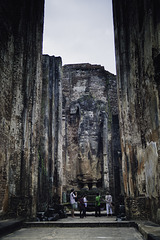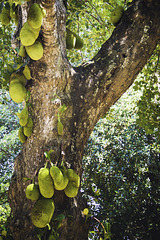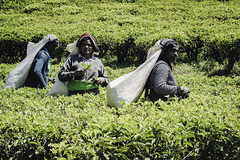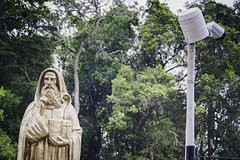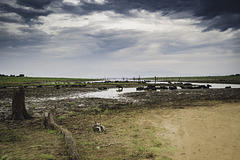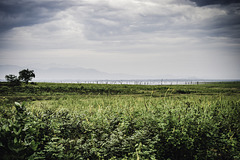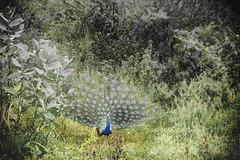
ශ්රී ලංකා Sri Lanka இலங்கை
Folder: Asia elsewhere
Heritage of the wise men and women
| |
|
|
Sandakada pahana, also known as Moon-stone , is a unique feature of the Sinhalese architecture of ancient Sri Lanka. It is an elaborately carved semi-circular stone slab, usually placed at the bottom of staircases and entrances. First seen in the latter stage of the Anuradhapura period, the sandakada pahana evolved through the Polonnaruwa, Gampola and Kandy period. According to historians, the sandakada pahana symbolises the cycle of Saṃsāra in Buddhism.
Our great friend
| |
|
|
|
Headlong
| |
|
|
|
A bigger friend
| |
|
|
Royal Botanic Gardens, Peradeniya are about 5.5 km to the west of the city of Kandy in the Central Province of Sri Lanka. Their origins date as far back as 1371 when King Wickramabahu III ascended the throne and kept court at Peradeniya near the Mahaweli river. This was followed by King Kirti Sri and King Rajadhi Rajasinghe. A temple was built on this location by King Wimala Dharma, but it was destroyed by the British when they were given control over the Kingdom of Kandy. Thereafter, the groundwork for a botanical garden was formed by Alexandar Moon in 1821. He used the garden for coffee and cinnamon plants.
The Botanical Garden at Peradeniya was formally established in 1843 with plants brought from Kew Garden, Slave Island, Colombo, and the Kalutara Garden in Kalutara. Today it is managed by the Division of National Botanic Gardens of the Department of Agriculture.
en.wikipedia.org/wiki/Royal_Botanical_Gardens,_Peradeniya
Jackfruit tree
| |
|
|
The jackfruit (Artocarpus heterophyllus), also known as jack tree, fenne, jakfruit, or sometimes simply jack or jak, is a species of tree in the fig, mulberry, and breadfruit family (Moraceae) native to South India. The jackfruit tree is well suited to tropical lowlands, and its fruit is the largest tree-borne fruit, reaching as much as 35 kg in weight. A mature jackfruit tree can produce about 100 to 200 fruits in a year. The jackfruit is a multiple fruit, composed of hundreds to thousands of individual flowers, and it is the fleshy petals that are eaten. The jackfruit tree is a widely cultivated and popular food item throughout the tropical regions of the world.
Tamil tea pickers
| |
|
|
|
Tamil tea pickers in Sri Lanka, most of whom are descendants of indentured laborers brought from southern India by British colonizers, play a crucial role in the country's tea industry, which is a significant part of its cultural heritage and economy. The tea industry in Sri Lanka, known for producing Ceylon tea, began in the 19th century when large amounts of labor were needed for the tea plantations. Even today, tea leaves in Sri Lanka are plucked by hand to ensure that only the tender leaves are selected, a labor-intensive task that has been historically undertaken by the Tamil workforce.
The cultural significance of Tamil tea pickers is deeply intertwined with the history of Ceylon tea itself. The tea industry was established during British colonial rule, and the Tamil workers have been a backbone of this industry since its inception. The tea they pick is renowned worldwide for its quality and contributes significantly to Sri Lanka's economy. In 2022, the industry generated £1.079 billion in exports despite facing a 26-year low in production due to an economic crisis.
However, the Tamil tea pickers have faced numerous challenges, including poverty, poor living conditions, and a lack of alternative employment opportunities. Many still live in the tiny homes built by the British, with some lacking basic amenities like running water or toilets[1]. Despite the global reputation of Ceylon tea and the wealth it generates, the Tamil tea pickers remain among the most disadvantaged segments of Sri Lankan society.
The tea industry's reliance on Tamil labor and the unique hand-plucking method contribute to the cultural significance of Ceylon tea. The Tamil tea pickers' contribution is not only economic but also a preservation of a traditional way of life that has been passed down through generations, despite the hardships they endure.
Tea shrubs in beautiful nature of Sri Lankan mount…
| |
|
|
|
Probably the best-known of Sri Lanka’s tea-growing districts, Nuwara Eliya is also the most rugged and mountainous, with the highest average elevation. The air is cool and bracing; the winds are scented with eucalyptus and wild mint. Rainfall is moderate except during the dry season, which falls between February and April. Nights are cold and sometimes frosty. This unique climate, combined with the terrain peculiar to the region, produces a tea that is recognized by connoisseurs as among the finest – if not the finest – in the world.
Historically speaking, Nuwara Eliya is a relatively new place. The town from which the district takes its name sits perched on a plateau 1,868 m above sea level, under the shadow of Sri Lanka’s highest mountain, Pidurutalagala. Almost inaccessible in olden times due to the precipitous, jungle-clad terrain surrounding it, this scenic plateau was effectively uninhabited when it was discovered by an English explorer in 1818. Impressed by its magnificent scenery and climate, Sir Edward Barnes, the British governor of the time, resolved to turn the locale into the similar of Ceylon, a fashionable hill-station to which the government and society of the capital, Colombo, could repair during the hottest and unhealthiest months of the year. He accomplished this by the simple expedient of building a house there himself, and occupying it every year between March and April. ‘Newralia’ thus became, for a few weeks every year, the capital of colonial Ceylon.
www.pureceylontea.com/index.php/nuwara-eliya
Saint and the camera
| |
|
|
Sky, water and buffalo
| |
|
|
|
Land of the elephants
| |
|
|
|
Peacock in action
| |
|
|
|
Jump to top
RSS feed- Latest items - Subscribe to the latest items added to this album
- ipernity © 2007-2024
- Help & Contact
|
Club news
|
About ipernity
|
History |
ipernity Club & Prices |
Guide of good conduct
Donate | Group guidelines | Privacy policy | Terms of use | Statutes | In memoria -
Facebook
Twitter



